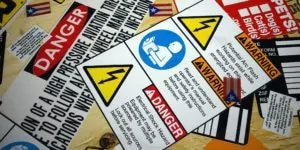Workplace safety is extremely important, especially in industrial environments. Chemicals, flammable substances, and other hazards have the potential for disaster. This can include damage to property, harm to workers, and putting the public at risk.
Properly marking hazardous chemicals and materials using safety placards ensures that anyone who comes into contact with hazardous substances will be aware of the threats they are exposed to.
Types of Safety Placards
Warning Labels & Placards
Safety placards are prevalent throughout most industrial facilities. Warning signs are affixed throughout factories and plants to provide critical information to workers.
Warning labels and signage is especially important in facilities that produce, house, or otherwise transport hazardous (and non-hazardous) materials.
It may seem like a basic safety solution. However, a simple warning placard can make the difference between proper procedures and the potential for an accident.
Inspection Tags
Inspections are one of the main ways industrial organizations keep their equipment, tools, and other storage up to code. Periodic inspections ensure that these assets are not damaged, leaking, or prone to failure.
Some examples of items commonly marked with inspection placards include:
- Equipment Nameplates
- Valves
- Utility Poles
- Fire Extinguishers
Inspectors rely on custom identification labels and markers to be effectively labeled to the inventory or equipment they are inspecting.
Transportation Placards
Plastic-based placards are frequently used on trucks and other types of vehicles that transport hazardous chemicals and other substances.
Hazmat placards are mandated by the Department of Transportation. Failure to comply with DOT placard guidelines may result in hefty fines and other penalties.
In the event of a leak or spill, placards provide vital information to clean-up crews. Hazmat teams need to know exactly what the substances are, so they can effectively remove all contaminates.
In addition, the team needs to properly protect themselves based on the situation. A lack of info could cause serious harm.
Similarly, in the event of an auto accident, first responders must know what is inside the vehicle in order to protect the parties involved as well as themselves.
A lack of information could lead to serious harm. For example, not knowing the truck was hauling a highly flammable substance could endanger anyone within a significant radius.
Industries
Identification placards are key safety components for a wide range of industries.
A few examples include:
- Manufacturing
- Oil & Gas
- Construction
- Energy
- Hazardous Materials
- Cell Phone Towers
- Transportation
- Many More!
Marking Processes
Photo Anodization
For an all-around marking process, photo anodization is a very versatile option. This marking is embedded between layers of tough aluminum, providing a long-lasting solution.
Photo anodization provides 20+ years of outdoor durability. Exposure to the elements is not a concern. This is a great benefit when your organization needs to mark an outside chemical tank or transportation vehicle. In addition, the anodized aluminum material is corrosive resistant.

This process is fully customizable, from high-quality barcodes to custom designs. Photo anodized placards can feature symbols to indicate the type of hazard. For example, a fire symbol might indicate a fuel tanker is flammable, while a skull and crossbones might indicate a toxic substance.
In addition to the custom design, the aluminum material can be colored, providing another method for visibly indicating the type of substance (i.e. red placard for a flammable chemical).
Digital Printing (Decals/Labels)
Outside of metal substrates, polyester and vinyl-based labels are used for safety marking as well. These materials are marked with digitally printed ink, allowing for a wide range of design options.

By directly printing on the material, these decals can be produced with bright, stand-out designs. This is a great benefit as their purpose is to draw attention and be noticed. Vivid colors, barcodes, and logos can all be added to these labels.
Some safety tags must be printed on labels. For example, GHS labels require red coloring on durable labels.
While the designs might be more vivid, digitally printed inks are not the most durable. Surface level printing on metal is very susceptible to wear. Laminates can provide some additional protection, but after the design is worn away, the label will be blank.
Wrap-Up
Safety placards of all varieties provide important safety information for a range of applications. From aiding in periodic inspections to accurately labeling hazardous chemicals, there is no limit to their utility.
With process options based on the durability needs of your application, there are placard solutions for any need.